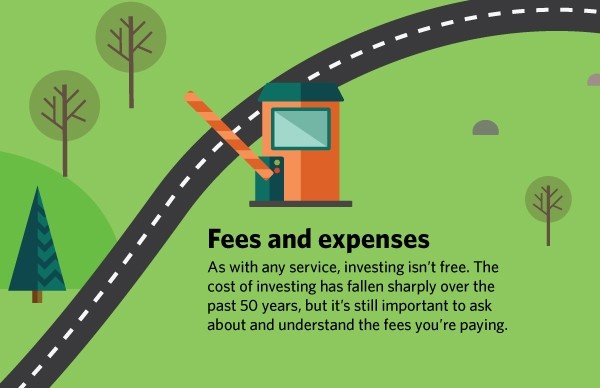
ICI Viewpoints
Investing Basics: Understanding Fees and Expenses

As part of the ICI Education Foundation’s 30th anniversary celebration, we are sharing a series of ICI Viewpoints explaining basic investing concepts, drawn from the ICI Education Foundation’s Investing Road Trip.
When I was growing up, my family would often make the long drive from the East Coast to visit family in the Midwest, and road trips bring back lots of memories—playing car bingo, listening to Paul Simon’s Graceland on cassette, and my parents driving through the night with us kids in pajamas. I also remember idling in seemingly endless lines at toll booths, with plenty of time to pepper my parents with questions: Why are we waiting? Does every car have to pay the toll? Where does the money go? My parents explained that every vehicle on the toll road pays and some of that money helps to maintain the road, which ultimately makes for a smoother and safer trip for everybody.
In the ICI Education Foundation’s Investing Road Trip, a toll booth illustrates the fees and expenses that are part of investing. Like with the toll roads, every investor pays some cost to invest but receives professional management and services in return.

Know Before You Go
Common types of investment fees include transaction fees—which you pay directly—and management fees—which are deducted before earnings are distributed to you. For each investment you own, it’s important to understand what you’re paying—and how much—because the fees to buy, maintain, and sell your investment can significantly affect your returns.
If you’re working with a financial professional, make sure you understand how and when that person is paid. Some financial professionals charge commissions when you buy or sell stocks, bonds, or some types of mutual funds, and some charge fees based on an hourly rate or a percentage of assets. Consider the services you get in exchange for the fees you’re charged.
In addition to the costs of buying the investment and receiving financial advice, you may also pay management fees. Mutual funds, for example, charge fees that represent the ongoing costs of managing the fund (often expressed as an expense ratio, which compares the fund’s expenses to its total net assets). These expenses are deducted from the fund’s earnings. Be sure to read the fund’s prospectus or summary prospectus, which clearly spell out the fund’s fees.
Fees are important, but they are not the only factor you should consider in choosing an investment. A higher-cost investment may make more money for you, even after accounting for the costs you pay, than a lower-cost alternative. Of course, the opposite may also be true. You also have to consider the risks in an investment and how it complements other investments in your portfolio.
Investors Vote with Their Feet on Fees
When looking at mutual fund expenses, one thing has become clear: over the past 20 years, investors’ increasing sensitivity to cost has—along with asset growth and resulting economies of scale—fueled a steady decrease in average expense ratios for both actively managed and index equity mutual funds. Inflows to funds continue to be concentrated in relatively low-cost funds.
While investors have shifted assets in lower-cost investments, it’s important to keep in mind that investors, like highway travelers, receive important services in exchange for the fees and expenses they pay. To be a well-informed and smart investor, be sure you understand what you’re paying and what you’re getting for your money. That makes for an epic investing road trip!
Other Posts in This Series
- Investing Basics: What Is Investing?
- Investing Basics: What Is Risk?
- Investing Basics: Types of Investments
- Investing Basics: Diversification
- Investing Basics: Dollar-Cost Averaging
- Investing Basics: Benefits of Mutual Funds
- Investing Basics: Tax Benefits to Encourage Saving
- Investing Basics: 529 Savings Plans
- Investing Basics: Compound Returns and the Power of Reinvestment
- Investing Basics: Understanding Fees and Expenses
